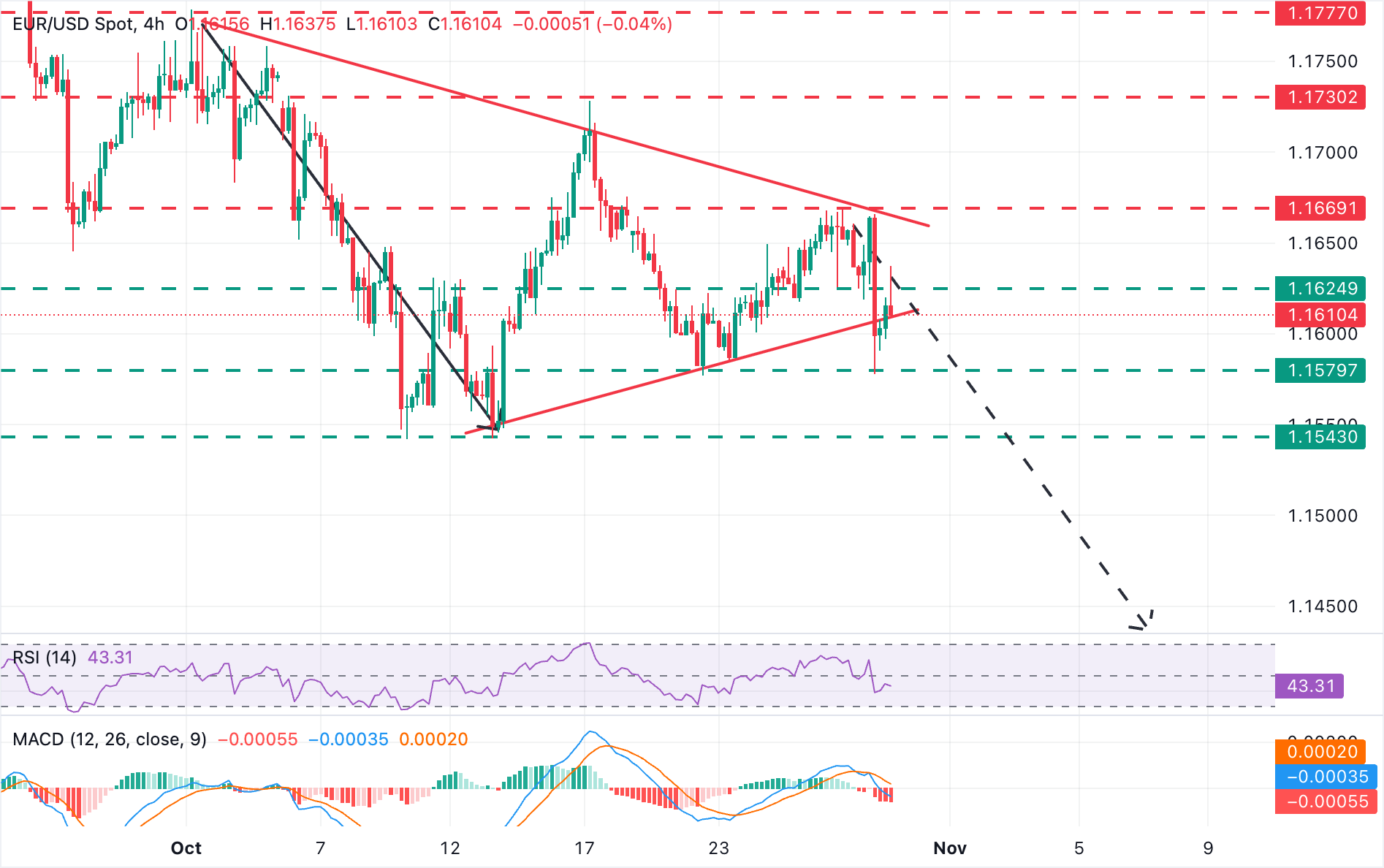Created
: 2025.10.30














![]() 2025.10.30 18:10
2025.10.30 18:10
EUR/USD is going through a mild recovery on Thursday, trading around 1.1620 at the time of writing, after having hit lows at 1.1580 on Wednesday. The positive reaction to a Sino-US trade deal has improved risk appetite somewhat, as the market turns its focus to the Eurozone Gross Domestic Product (GDP), and the European Central Bank's (ECB) monetary policy decision.
US President Donald Trump affirmed on Thursday that he had an "amazing" meeting with Chinese President Xi Jinping. The US will reduce tariffs on Chinese imports while the Asian country will keep rare earths trade flowing, resume purchases of US soybeans, and stop the fentanyl trade.
The reaction of Chinese President Xi has been more laconic, but he acknowledged a consensus on "important economic and trade issues". Investors have welcomed the news, but the market reaction has been moderate.
On Wednesday, the Federal Reserve cut interest rates by 25 basis points (bps) as widely expected, but Chairman Jerome Powell shocked markets, putting into question another cut in December. The US Dollar surged across the board following Powell's press conference.
The table below shows the percentage change of Euro (EUR) against listed major currencies today. Euro was the strongest against the Japanese Yen.
| USD | EUR | GBP | JPY | CAD | AUD | NZD | CHF | |
|---|---|---|---|---|---|---|---|---|
| USD | -0.14% | 0.00% | 0.41% | -0.00% | -0.05% | -0.07% | -0.13% | |
| EUR | 0.14% | 0.14% | 0.57% | 0.14% | 0.09% | 0.07% | 0.01% | |
| GBP | -0.00% | -0.14% | 0.40% | 0.00% | -0.04% | -0.07% | -0.13% | |
| JPY | -0.41% | -0.57% | -0.40% | -0.41% | -0.45% | -0.51% | -0.57% | |
| CAD | 0.00% | -0.14% | 0.00% | 0.41% | -0.03% | -0.08% | -0.13% | |
| AUD | 0.05% | -0.09% | 0.04% | 0.45% | 0.03% | -0.03% | -0.08% | |
| NZD | 0.07% | -0.07% | 0.07% | 0.51% | 0.08% | 0.03% | -0.03% | |
| CHF | 0.13% | -0.01% | 0.13% | 0.57% | 0.13% | 0.08% | 0.03% |
The heat map shows percentage changes of major currencies against each other. The base currency is picked from the left column, while the quote currency is picked from the top row. For example, if you pick the Euro from the left column and move along the horizontal line to the US Dollar, the percentage change displayed in the box will represent EUR (base)/USD (quote).

The EUR/USD keeps looking for direction, with price action moving within an ever-narrowing range, forming a symmetrical triangle. This is considered a continuation pattern, which points to a nearish outcome. Technical indicators support that view. The 4-hour Relative Strength Index (RSI) is below 44, and the Moving Average Convergence Divergence (MACD) has crossed below the signal line.
Wednesday's impulsive bearish candle suggests an increasing bearish momentum, although the support area near 1.1580 (October 22, 23 lows) keeps limiting downside attempts and closing the path towards the key support area around 1.1545 (October 9 and 14 lows). The measured target of the triangle pattern is at the 1.1450 area.
To the upside, the pair is struggling to extend gains above a previous support at 1.1625 (October 28 low). Above here, the top of the triangle pattern comes around 1.1665, and the October 28 and 29 highs lie around 1.1670. Further up, the next target is the October 17 high, near 1.1730.
The European Central Bank (ECB) in Frankfurt, Germany, is the reserve bank for the Eurozone. The ECB sets interest rates and manages monetary policy for the region. The ECB primary mandate is to maintain price stability, which means keeping inflation at around 2%. Its primary tool for achieving this is by raising or lowering interest rates. Relatively high interest rates will usually result in a stronger Euro and vice versa. The ECB Governing Council makes monetary policy decisions at meetings held eight times a year. Decisions are made by heads of the Eurozone national banks and six permanent members, including the President of the ECB, Christine Lagarde.
In extreme situations, the European Central Bank can enact a policy tool called Quantitative Easing. QE is the process by which the ECB prints Euros and uses them to buy assets - usually government or corporate bonds - from banks and other financial institutions. QE usually results in a weaker Euro. QE is a last resort when simply lowering interest rates is unlikely to achieve the objective of price stability. The ECB used it during the Great Financial Crisis in 2009-11, in 2015 when inflation remained stubbornly low, as well as during the covid pandemic.
Quantitative tightening (QT) is the reverse of QE. It is undertaken after QE when an economic recovery is underway and inflation starts rising. Whilst in QE the European Central Bank (ECB) purchases government and corporate bonds from financial institutions to provide them with liquidity, in QT the ECB stops buying more bonds, and stops reinvesting the principal maturing on the bonds it already holds. It is usually positive (or bullish) for the Euro.
![]()
Created
: 2025.10.30
![]()
Last updated
: 2025.10.30

FXStreet is a forex information website, delivering market analysis and news articles 24/7.
It features a number of articles contributed by well-known analysts, in addition to the ones by its editorial team.
Founded in 2000 by Francesc Riverola, a Spanish economist, it has grown to become a world-renowned information website.
We hope you find this article useful. Any comments or suggestions will be greatly appreciated.
We are also looking for writers with extensive experience in forex and crypto to join us.
please contact us at [email protected].
Disclaimer:
All information and content provided on this website is provided for informational purposes only and is not intended to solicit any investment. Although all efforts are made in order to ensure that the information is correct, no guarantee is provided for the accuracy of any content on this website. Any decision made shall be the responsibility of the investor and Myforex does not take any responsibility whatsoever regarding the use of any information provided herein.
The content provided on this website belongs to Myforex and, where stated, the relevant licensors. All rights are reserved by Myforex and the relevant licensors, and no content of this website, whether in full or in part, shall be copied or displayed elsewhere without the explicit written permission of the relevant copyright holder. If you wish to use any part of the content provided on this website, please ensure that you contact Myforex.
Myforex uses cookies to improve the convenience and functionality of this website. This website may include cookies not only by us but also by third parties (advertisers, log analysts, etc.) for the purpose of tracking the activities of users. Cookie policy